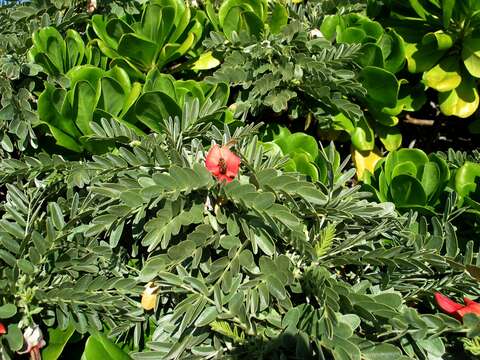Sesbania tomentosa

Kuvaus:
OhaiFabaceae (Legume or Pea family)Endemic to the Hawaiian Islands (All the main islands and some of the Northwest Islands*)NatureServe: Imperiled; Endangered Kaena Point, Oahu (foreground) growing with naupaka kahakai (Scaevola taccada). Kaena Point is located on the western tip of the island of Oahu.This particular form of ohai survives only here in this very restricted area. Seen here, an introduced European honey bee (Apis mellifera) pollinates flowers. However, native Hawaiian Yellow-faced bees (Hylaeus spp.), much smaller, also found here and are the original pollinators of many native plants.Habitwww.flickr.com/photos/dweickhoff/5188545262/in/photostream/Ohai were one of the favored lei flowers by early Hawaiians. On Niihau, they called this plant ohai o Papiahuli, the meaning is unknown.Ohai are still used today in lei and strung much like other native pea-like flowers, such as wikiwiki, mmane, nanea, nuku iiwi, and wiliwili.EtymologyThe generic name Sesbania is derived from sesban, the Arabic name for Sesbania sesban (syn S. aegyptiaca), Egyptian rattlepod.The specific epithet tomentosa means "furry" or literally "covered with matted hairs," though not all forms are furry._____* In the Northwest Islands ohai is found on Necker (Mokumanamana) and is a rather common component in the shrubland on Nhoa (Moku Manu).NPH00007nativeplants.hawaii.edu/plant/view/Sesbania_tomentosa
Mukana seuraavilla sivuilla:
- Life
- Cellular
- Eukaryota (aitotumaiset)
- Archaeplastida
- Chloroplastida
- Streptophyta
- Embryophytes
- Tracheophyta
- Spermatophytes (siemenkasvit)
- Angiosperms (kaksisirkkaiset)
- Eudicots
- Superrosids
- Rosids
- Fabales
- Fabaceae (Hernekasvit)
- Sesbania (Kolibrinpavut)
- Sesbania tomentosa
Tämä kuva ei ole esillä missään kokoelmassa.
Lähdetiedot
- lisenssi
- cc-by
- tekijänoikeus
- David Eickhoff
- valokuvaaja
- David Eickhoff
- alkuperäinen
- alkuperäinen mediatiedosto
- käy lähteessä
- kumppanisivusto
- Flickr Group
- ID


